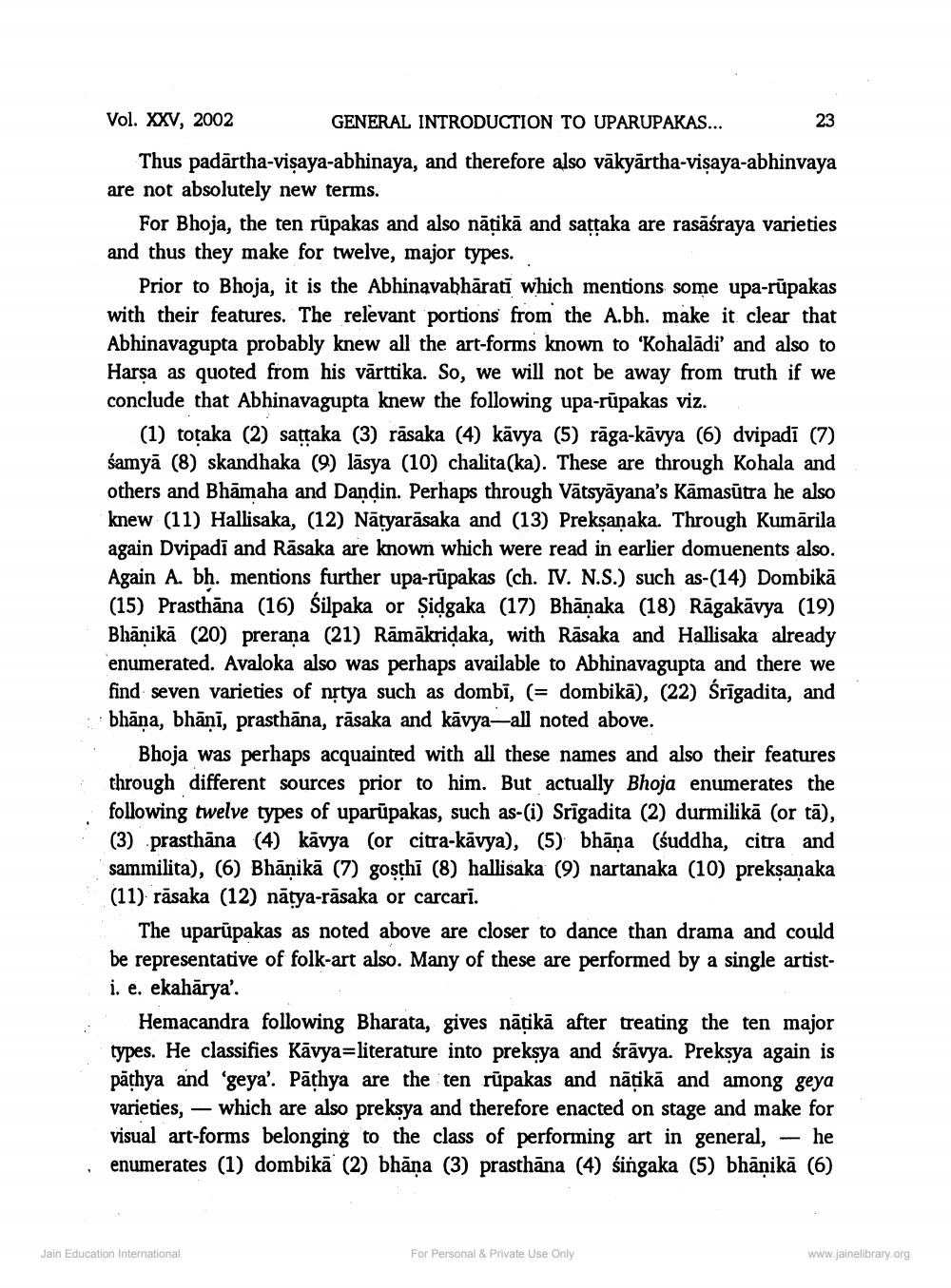________________
Vol. XXV, 2002
GENERAL INTRODUCTION TO UPARUPAKAS...
23
Thus padārtha-visaya-abhinaya, and therefore also vākyārtha-visaya-abhinvaya are not absolutely new terms.
For Bhoja, the ten rūpakas and also nātikā and sattaka are rasāśraya varieties and thus they make for twelve, major types.
Prior to Bhoja, it is the Abhinavabhārati which mentions some upa-rūpakas with their features. The relevant portions from the A.bh. make it clear that Abhinavagupta probably knew all the art-forms known to 'Kohalādi' and also to Harsa as quoted from his vārttika. So, we will not be away from truth if we conclude that Abhinavagupta knew the following upa-rūpakas viz.
(1) toțaka (2) sattaka (3) rāsaka (4) kävya (5) rāga-kāvya (6) dvipadi (7) śamyā (8) skandhaka (9) lāsya (10) chalita (ka). These are through Kohala and others and Bhāmaha and Dandin. Perhaps through Vātsyāyana's Kāmasūtra he also knew (11) Hallisaka, (12) Nātyarāsaka and (13) Preksanaka. Through Kumārila again Dvipadi and Rāsaka are known which were read in earlier domuenents also. Again A. bh. mentions further upa-rupakas (ch. IV. N.S.) such as-(14) Dombikā (15) Prasthāna (16) Silpaka or şidgaka (17) Bhānaka (18) Rāgakāvya (19)
kā (20) prerana (21) Rāmākridaka, with Rāsaka and Hallisaka already enumerated. Avaloka also was perhaps available to Abhinavagupta and there we find seven varieties of nộtya such as dombi, (= dombikā), (22) Śrīgadita, and bhāna, bhānī, prasthāna, rāsaka and kavya—all noted above.
Bhoja was perhaps acquainted with all these names and also their features through different sources prior to him. But actually Bhoja enumerates the following twelve types of uparūpakas, such as-(i) Srigadita (2) durmilikā (or tā), (3) prasthāna (4) kavya (or citra-kavya), (5) bhāna (śuddha, citra and sammilita), (6) Bhānikā (7) gosthi (8) hallisaka (9) nartanaka (10) preksanaka (11) rāsaka (12) nātya-rāsaka or carcari.
The uparūpakas as noted above are closer to dance than drama and could be representative of folk-art also. Many of these are performed by a single artisti. e. ekahārya'.
Hemacandra following Bharata, gives nātikā after treating the ten major types. He classifies Kāvya=literature into preksya and śrāvya. Preksya again is pāthya and 'geya'. Pāěhya are the ten rūpakas and nātikā and among geya varieties, — which are also preksya and therefore enacted on stage and make for visual art-forms belonging to the class of performing art in general, – he enumerates (1) dombikā (2) bhāņa (3) prasthāna (4) singaka (5) bhānikā (6)
Jain Education International
For Personal & Private Use Only
www.jainelibrary.org




